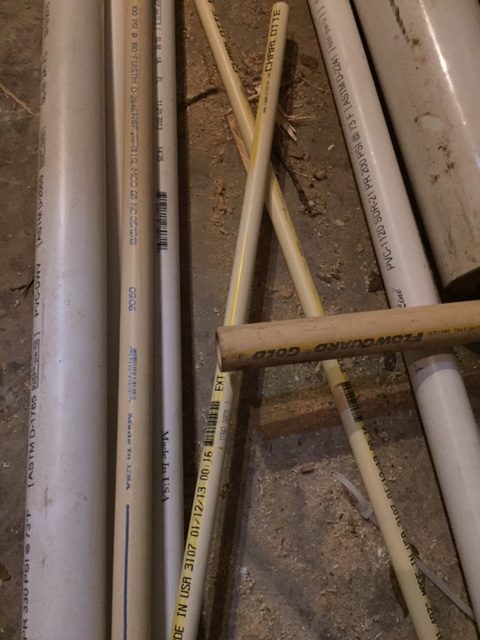 What’s the difference between PVC and CPVC? Simply put, CPVC is used for hot water applications while PVC is used for cold water applications.
What’s the difference between PVC and CPVC? Simply put, CPVC is used for hot water applications while PVC is used for cold water applications.
Visually, the only difference between the two is color. PVC is generally white (for water distribution systems) while CPVC is a beige color. However, there is a major difference on the molecular level.
**Warning** Complex Chemistry ahead may hurt your brain – if you don’t care, skip the chemistry section
CPVC is an abbreviation for Chlorinated Polyvinyl Chloride. Huh? Chlorinated chloride? Yep, and it gets pretty complex. Polyvinyl Chloride is is created from hydrogen, carbon and chlorine through a chemical process called polymerization. This thermoplastic is the base for all PVC products which generally include various additives to chemically change its physical properties to suit the specific need.
For example, plasticizers can be added to make the PVC product more flexible. Pigments can be added to create a specific color. Fillers can increase the volume of the finalized product without the additional costs. Lead was controversially used but had been previously phased out in the past few years.
Virtually all finished products you can purchase has additives, sometimes many of them. What makes CPVC unique from the various stabilizers and additives that are mixed in with PVC, manufacturers use a process called “free radical halogenation”. We won’t delve into any organic chemistry, but essentially chlorine gas is introduced to PVC and using UV light to kickstart a chemical reaction that adds more chlorine to the molecules.
End of Chemistry
What this all boils down to is CPVC has additional chlorine atoms in its molecular structure that allows it to withstand greater heat temperatures. That’s it!!
CPVC can generally work with temperatures up to about 200°F while PVC is limited to about 140°F. That difference gap may not look like much but it means a lot considering many water heaters are set to 110°F – 130°F and can be even higher.
Probably the most significant difference in the two from the perspective of DIYers is the sizing. I have no idea why they did this, but a 1/2″ PVC pipe is a different size from a 1/2″ CPVC pipe. The reason is that PVC follows the IPS schedule standard (iron pipe size) and CPVC falls under the CTS standard (copper tubing size) which has two completely different diameters. Why do you care? Because your PVC fittings will not work on CPVC pipe and vice-versa.
Even if you were to find a match between CPVC and PVC, you may run into a slight problem: CPVC and PVC use two different solvent glues. There are glues that can be used on both, but do you really want a joint glued with inferior stuff? Of course not, so make sure you match your solvents to your pipe.
Aside from the temperature and sizing difference, the materials are remarkably similar. Pigments are added to CPVC to differentiate it by sight from PVC and different cements are used on joints but it’s durability, workability and strength are about the same.
So if CPVC is just PVC on steroids, why don’t we use it everywhere?
The answer is simple, and I’m sure you’ve probably already guessed it. It comes down to cost. CPVC is more expensive than PVC, so like all aspects of engineering, designs are created to use the least expensive materials possible to effectively achieve the desired structural strength requirements for a given problem.
Isn’t that all engineering really is? I can guarantee my redneck cousin Billy can build a shed that has the strength to last decades, but can he do it with the least amount of materials required? That’s what structural engineers are ultimately paid to do, but that’s a soapbox speech for another article.
The bottom line is, save your money and use CPVC on hot water applications like residential plumbing systems and PVC for drainage and irrigation systems. Before you decide, though, check with your local building codes.
Leave a Reply